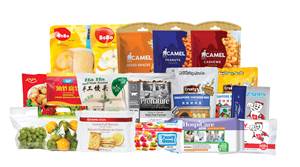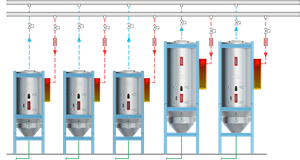Seven-Layer R&D Line Spurs Blown Film Innovation
Business might be slow in most blown film extrusion markets, but leading-edge processors are preparing for better times by tapping into a seven-layer line installed last year at Dow Chemical Co.’s Film Application Development Center (FADC) in Freeport, Tex.
Business might be slow in most blown film extrusion markets, but leading-edge processors are preparing for better times by tapping into a seven-layer line installed last year at Dow Chemical Co.’s Film Application Development Center (FADC) in Freeport, Tex. The line was part of Dow’s $5.2 million expansion of its FADC.
The line, furnished on a turnkey basis by Hosokawa Alpine American, Natick, Mass. (halpine.com), went up in February 2009. It was unveiled publicly during June’s NPE 2009 show in Chicago, when live demonstrations were shown on screens in Alpine’s booth.
Since the 2009 installation, Dow (plastics.dow.com) has had roughly 45 different customers in for more than 100 trials, says Greg Bunker, lead development specialist. “We’re not talking about a lab line here, but a full-scale production line that permits processors to produce commercial-grade film, allows them to experiment, to invent,” Bunker notes. Dow’s investment came during what has been perhaps the film industry’s worst economic slump ever. And it suggests that one way processors can emerge from it is to innovate.
“Customers who have come in to use the equipment run the gamut from those who are more familiar with monolayer production to ones with three-layer capacity who are looking to jump to more complex five- to seven-layer structures,” says Bunker. More than one processor has used the line for a short run of a brand-new film in order to “seed the market” with commercial-grade product to gauge customer reaction without occupying its own production equipment.
Confidentiality agreements preclude Dow from divulging who is making what on this line. “But we’re seeing things that have never been done before, both in the way of film structures and material combinations and penetration into new markets,” Bunker says.
The Alpine line has seven 50-mm, grooved-feed extruders with 30:1 L/D. It is equipped Alpine’s patented X die, which is designed to eliminate port lines. Dow has 200- and 250-mm die inserts. Bunker remarked on how quickly the die purges, which is critical where product changeovers are
the norm and setup time must minimized. Film gauge is regulated by Alpine’s segmented air ring. The line is also furnished with Alpine’s Resin Miser control system. Bunker says the fastest Dow has run the line is at 20 lb/in. of die circumference, though that is not the limit. Alpine says the line is rated at 1000 lb/hr.
Some of what Dow has run in Freeport are these structures:
- Four-mil-thick, three-layer structures for shipping sacks, the core of which is its high-melt-strength Inspire HMS PP.
- A 7-layer, 4-mil barrier film featuring Dow’s latest offering in the Dowlex LLDPE resin family, XUS 61530.04.
- Two-layer, 2-mil film for cookies, crackers, and other dry-food applications. The key material is Dow’s Elite 5960G enhanced PE.
- A 5-layer, 2.5 mil, high-clarity lamination sealant film for food packaging. Dow’s Elite 5940 provides clarity, stiffness and toughness to the film as the B component of the A/B/C/D structure.
- Three-layer, 4-mil stretch-hood film, run in an ABC formulation. A core layer of Dow’s Affinity polyolefin plastomer blended with Dow 1321 LDPE is sandwiched between a developmental Dowlex NG LLDPE grade, XUS 61530.02.
Related Content
Flexible-Film Processor Optimizes All-PE Food Packaging
Tobe Packaging’s breakthrough was to create its Ecolefin PE multilayer film that could be applied with a specialized barrier coating.
Read MoreHow to Effectively Reduce Costs with Smart Auxiliaries Technology
As drying, blending and conveying technologies grow more sophisticated, they offer processors great opportunities to reduce cost through better energy efficiency, smaller equipment footprints, reduced scrap and quicker changeovers. Increased throughput and better utilization of primary processing equipment and manpower are the results.
Read MoreBreaking the Barrier: An Emerging Force in 9-Layer Film Packaging
Hamilton Plastics taps into its 30-plus years of know-how in high-barrier films by bringing novel, custom-engineered, nine-layer structures resulting from the investment in two new lines.
Read MoreFollow These Tips to Fire Up Your Cold Blown Film Line
Firing up a cold blown-film line after a shutdown involves multiple pieces of equipment that all interact. Here’s a look at those components individually and some best practices on how to get your line up and running as quickly and safely as possible.
Read MoreRead Next
For PLASTICS' CEO Seaholm, NPE to Shine Light on Sustainability Successes
With advocacy, communication and sustainability as three main pillars, Seaholm leads a trade association to NPE that ‘is more active today than we have ever been.’
Read MorePeople 4.0 – How to Get Buy-In from Your Staff for Industry 4.0 Systems
Implementing a production monitoring system as the foundation of a ‘smart factory’ is about integrating people with new technology as much as it is about integrating machines and computers. Here are tips from a company that has gone through the process.
Read MoreSee Recyclers Close the Loop on Trade Show Production Scrap at NPE2024
A collaboration between show organizer PLASTICS, recycler CPR and size reduction experts WEIMA and Conair recovered and recycled all production scrap at NPE2024.
Read More












